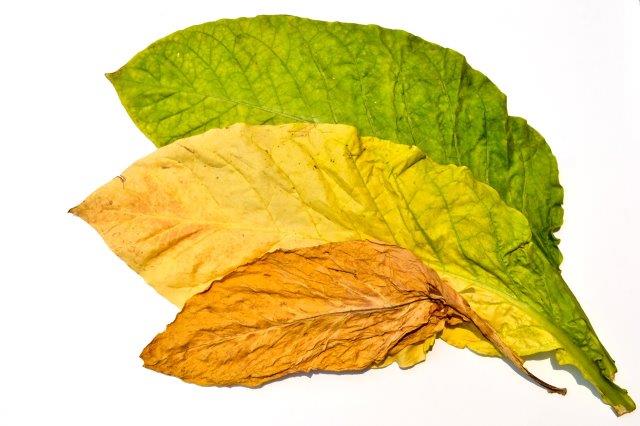- Latin Name: Genus Nicotiana
- USDA Zone: Annual 2-12
- Days to Harvest: 70-130 days
- Days to Maturity: 100-130 days
- Days to Germination: 7-14 days
- Seeding Depth: Press without covering
- Plant Width: 18-36”
- Plant Height: 36-60”
- Plant Spacing: 12-36”
- Row Spacing: 36-60”
- Growth Habit: Upright broadleaf
- Soil Type: Moist, loamy, well-drained
- Temp Preference: 65-85 °F
- Light Preference: Full sun - partial sun
- Humidity Preference: 60-68 %
- Pests and Diseases: Hornworms, flea beetles, aphids, and cutworms. Keep soil well-drained and ventilated to minimize several types of fungal, mold, and rot development.

Please Note: Tobacco plants have countless uses including herbal poultices and other medicinal applications for both humans and animals, ornamental applications, religious and ceremonial uses and many more. Tobacco for human consumption such as smoking or chewing, is addictive and has serious and proven health risks. We offer tobacco seeds in the interest of a thorough selection of legal seeds of all kinds. We absolutely do not promote or encourage human consumption of tobacco products by anyone. That being said, we respect the right of informed adults to decide as they may.
How to Grow Tobacco Seeds
Tobacco is one of the few garden seeds that requires no introduction. Whether a gardener or not, nearly anybody can share something historically or culturally significant about the tobacco plant except for, likely, how it’s grown and germinated.
Like many herb seeds, tobacco seed is extremely small, difficult to handle, and can be challenging to germinate but, once sprouted and rooted in the garden, will flourish like a weed with little attention needed up until harvest.
While there are many types of ornamental tobacco, the following growing guide and tips are intended for curable and smokable members of Nicotiana that have been cultivated for personal use for nearly 7,000 years.
Starting Tobacco Seeds
- About 7-14 days to germination
- Overseed to allow for failed germination
- Use greenhouse dome for increased humidity
Begin seeds indoors 6-8 weeks prior to final frost date in a 72-cell starting tray to allow for plenty of successful and unsuccessful germination attempts.
Lightly fill trays with about 3” of fine potting mix (not potting soil). Do not use garden soil.
Sift potting mix to remove clumps that could impede growth. Thoroughly soak potting mix in trays and allow to drain before sowing.
Because tobacco seeds are so small, evenly sprinkle seeds over all 72 cells in the starting tray without being too particular. Once sown, mist with a spray bottle and do not cover seeds in a top layer of potting mix. Using either a greenhouse dome or simple plastic wrap, cover the tray to create humidity and ideal conditions of about 70-80 °F (not to exceed 85 °F).

Keep seeds in a sunny location while leaving a corner propped open to allow for air flow. Continue to mist with a spray bottle until germination 7-14 days after seeding.
Once sprouted, remove greenhouse dome or plastic wrap and immediately place starts 1-2” from a grow light. Placing seedlings 1-2” from grow lights will keep starts from becoming too leggy and tall, causing uneven development in the garden.
Keep soil moist but not saturated as it may stunt root development. As seeds mature, select the best starts to thin and divide into larger individual containers until ready for outdoor transplanting.
Tobacco Plant Soil
- Do not use common garden or potting soil
- Binder-Wrapper Tobacco Soil: Light, sandy, sandy-loam
- Dark-Filler Tobacco Soil: Medium-heavy, clay, clay-loam
The tobacco plant is native to a diverse array of humid climates throughout the world and, regardless of type, generally all thrive in the same consistently moist conditions.
Whether growing out in the garden or in a portable container, be sure that your soil is always well-drained and properly ventilated to help prevent various types of mold, fungus, and rot. However, not all members of Nicotiana are the same and, depending on use, some types require a slightly different soil makeup.
Tobaccos used primarily as a binder-roller tobacco such as Pennbel 69, Catterton, and any Maryland strands (MD 609) are best grown on sandy and loamy soils.
Tobaccos used exclusively as a filler such as Burley types and any and all dark-leaf cultivars such as Adonis, Criollo, and Shirey cultivars are said to perform and taste best when grown in slightly heavier, silty, and clay-based soils.
Watering Tobacco Plants
- Keep moist but not overly saturated
- Susceptible to mold, fungus, and rot
- 60-68% humidity should provide adequate moisture
Regardless of cultivar or use, members of Nicotiana are all native to the sweltering and humid tropics throughout the world and still thrive from the same moist conditions. Understanding your region’s average humidity will greatly help manage proper watering techniques for your tobacco plants.
Tobacco thrives best in regions with an average atmospheric humidity of about 60-68%, which is largely responsible for keeping soil adequately moist. Gardeners in drier regions will have to work harder to maintain soil moisture to keep plants from wilting.
The genus Nicotiana is widely susceptible to a number of diseases caused by overly saturated soils including Fusarium Wilt, downy mildew, black root rot, Tobacco Mosaic Virus (TMV), bacterial leaf spot, and black shank.
Transplanting Tobacco

- Focuses energy on root development when transplanted
- Transplant after 2 sets of true leaves have developed
- Benefits from nitrogen-based fertilizers when transplanted
During these first two weeks in the garden, tobacco plants will use most of their energy for root production and, on the surface, will show signs of wilting and seem to have stopped growing.
Once firmly rooted, tobacco requires little watering and only a light addition of fertilizer 4-6 weeks later.
Tobacco is ready for transplanting once two sets of true leaves have developed. Harden off outside 2-4 hours per day for a week before transplanting.
Similar to tomatoes or sweet corn, tobacco is a heavy nitrogen feeder benefiting from an organic fertilizer prior to transplanting.
Traditionally, soil is amended with wood ash for tobacco cultivation.
Is Tobacco A Perennial?
Yes! Tobacco plant is technically a frost-tender perennial in some of the warmest regions on earth. The genus Nicotiana is home to several species of ornamental flowering tobacco grown all over the country, tolerant of more extreme conditions than traditional cigar tobacco plants.
The genus Nicotiana is indigenous to the humid perennial tropics across Asia and the Americas, where it still thrives year-round in both the wild and commercial production. Most varieties of harvestable Nicotiana are grown exclusively as annuals because they require at least 4 frost-free months during the growing season.
Exclusive to the rare tropics of the United States, growers in USDA Hardiness Zones 9-12 may experience the joys of gardening tobacco during the warm winter months. Tobacco is not a fruiting crop and does not rely on pollinators during these winter months.
Tobacco plants are fast growing annuals known to readily reseed themselves in the autumn like every other garden crop.
Tobacco Plants in Winter
- Requires 4 frost-free months
- Perennial in hardiness zones 9-12
- Performs like tomato and pepper in winter months
Closely related to tomatoes, peppers, and eggplant, tobacco is a member of the nightshade family and performs nearly identically in the winter as other members of Solanaceae.
While eggplant and pepper are technically perennials as well, they too are treated as simple annuals because they rarely have the warm winter conditions to support perennial growth.
Sometimes the first snowfall or frost date can surprise gardeners and, if not prepared, is liable to ruin an entire harvest. Both ornamental and harvestable tobacco plants thrive in portable containers and 5-gallon buckets, allowing them to be brought in for harvest in the face of an unpredictable autumn.
Even in winter months, be sure atmospheric humidity remains 60-68 %.
Growing Tobacco Plants in Pots
As a member of Solanaceae, tobacco plants perform as reliably in pots and containers as tomato, pepper, eggplant, and potatoes.
Growing tobacco in 3-5 gallon buckets is widely recommended for home growers because it helps reduce many problems faced when sown in the garden bed.
Tender young tobacco plants can be difficult to weed around in the garden bed because Nicotiana leaves can be easily bruised and damaged before maturity.
Tobacco grown in individual containers allows home gardeners to more easily manage their plant health including soil moisture, sun, pests, disease, pH levels, weeding, and humidity.

How to Care for Tobacco Plants in Pots
- Nearly identical to tomato, pepper, and eggplant care
- Watch for pots and containers to quickly dry out soil
- Benefits from nitrogen-based tomato fertilizers
Tobacco plants grown in convenient pots and containers benefit from the same conditions as those transplanted directly to the garden bed. Properly ventilated containers are ideal for crops such as tobacco and mint that thrive from reliable drainage without drying out. Although movable pots are one of the best ways to grow tobacco seeds, be sure to keep a close eye on saturation since patio pots and containers are notorious for dehydrating soils because of their steady and reliable drainage.
Plants perform nearly identical to tomato, pepper, and eggplant and, depending on variety, will benefit from some staking in the later season as broad, heavy leaves prepare for harvest.
Similar to Brassicas and other leafy greens, tobacco is neither a fruiting crop nor a root vegetable and thrives from a steady nitrogen-based fertilizer or any standard Tomato fertilizer.
How to Prune Tobacco Plants
Ornamental tobacco plants benefit from the same seasonal deadheading as other flowers to prolong their annual life in the garden. However, tobacco plants grown for harvest rather than showy blooms are pruned slightly differently to prolong their flavor and stay-power in the garden.
Because harvestable tobacco is grown for leaf production, it is important to remove all leafy “suckers” from the plant that direct energy away from producing broad, flavorful leaves.
Unlike leafy vegetable greens that lose flavor once they’ve bolted to seed, tobacco actually thrives from this late-season bolting which helps ensure maximum flavor in the tobacco leaves. Keeping your garden free from weeds and “suckers” is paramount to overall tobacco plant health.



Removing Suckers from Tobacco Plants
- Suckers are small leaves that grow upright from the stem
- They are not broad primary leaves, but small and thin energy-suckers
- Suckers can easily be pinched, snapped, or clipped off by hand
Pruning, pinching, and deadheading plants is only intimidating the first time you try it. But it only takes a few times before you’re feeling like a pro.
You may feel nervous about differentiating the “sucker” leaves from the “true” leaves, but they are hard to tell apart because the suckers are thin, meager, and grown upright between the stem and base of the leaf.
Their growth clearly doesn’t belong when compared to the broad and attractive “true” leaves.
Harvesting Tobacco Leaves
The tobacco plant is one of the easiest crops to harvest because, like herbs, it is solely cultivated for vegetation and does not produce any fruit or edible roots.
Unlike herbs such as lavender, thyme, or rosemary, tobacco leaf is dried and cured very differently to best prepare the leaf in a flavorful and smokable form.
Depending on cultivar, most tobacco plants are ready to harvest in about 100 days from transplanting or as soon as 70 days once the bottom leaves begin to show an even golden discoloration.
While leafy greens such as mustard and collards are best harvested while a verdant dark green color, tobacco should always be left to yellow on its own in the garden for optimal curing and flavor.
When to Harvest Tobacco
- After seed pods have dried and turned brown
- When leaves have turned pale yellow and golden
- Harvesting green leaves compromise curing and flavor
Tobacco harvest generally begins in August for most of the country, especially growers that started their tobacco seeds early for transplanting.
Although region, cultivar, and seasonal conditions will affect the general harvest window for most crops, tobacco plants are best harvested when their bottom leaves (oldest growth) begin to turn a seasonal pale golden yellow, regardless of month.
Continue to harvest leaves through the season as the rest of the plant and upper leaves (newest growth) slowly turn the same pale golden yellow.
Tobacco is most commonly harvested leaf-by-leaf, but may also be harvested whole only if the entire plant has turned an even golden yellow. Green chlorophyll-dense leaves will compromise the curing process, flavor, and profile.

How to Harvest Tobacco
- Harvest the entire plant at once (or)
- Harvest individual leaves as they yellow
- Allow to wilt for 12-48 hours before curing
Tobacco leaves are relatively tender at any stage and can be simply cut and removed from the plant with gardening shears or clippers. Most tobacco leaves should have at least 3-5” of stem available to clip from at the time of harvest.
Avoid cutting the leaf itself which is known to affect the curing process. Try to clip the individual leaves as close to the base as possible.
If harvesting the entire plant, cut at the base and allow the plant to wilt outdoors for 12-48 hours to prepare for curing. When cutting plants whole, tobacco is notorious for quickly rusting out tools and equipment because of the natural water content within the plant.
Curing Tobacco Leaves
Curing your leaves is the last and defining step of your journey, as it is arguably the most important and laborious process to growing your own tobacco.
While proper germination and growing conditions are essential to developing a healthy plant, it is the curing process that fully accentuates the true flavor, potential, and smokability of your home-grown tobacco.
Some growers argue that tobacco leaves neither need to dry nor cure fully to produce optimal flavor and smoking.
We simply ask that you try for yourself before short-changing all your hard work for a less-than-perfect product.
Any dark and well-ventilated space such as a barn, shed, or basement serves as an ideal location to cure your leaves for 4-8 weeks. For best results, maintain a 70-80° humidity without allowing water and moisture to make direct contact with your crop.
How to Cure Tobacco

- Dark, dry location with 70-80% humidity
- Air-cured tobacco is ready in 4-8 weeks
- Improperly cured tobacco leaves are unsmokable
Harvested leaves and plants should be hung ½” from each other to cure and dry in a location with an average 70-80% humidity such as a basement or outdoor shed.
If the leaf dries too quickly without properly curing (turning yellow) then it will be unsmokable.
Allow leaves to continue drying until main stem snaps like a twig. Once cured and dried, the leaf can be left to hang and age where it is.
Aging allows time for nitrogen compounds in the leaf to break down, removing the harshness of freshly cured tobacco and allowing true flavors to be accentuated.
Types of Tobacco
There are about as many varieties of tobacco plants as there’s got to be tomatoes, peppers, cucumbers, or any other garden favorite.
Whether growing ornamentally or looking to harvest, there are almost countless types of tobacco seeds for nearly any warm, humid garden on earth.
Tobacco is grown as either a wrapper, binder, or filler as the three components of a cigar and even those three categories offer an endless variety of seeds that’ll leave you feeling dizzy.
Similar to wine, harvestable tobacco is valued for its growing region, believed that certain flavors and characteristics are developed only in certain regions of the world.
Some of the most popular tobacco growing regions include Dominican Republic, Connecticut River Valley, Cuba, Indonesia, Nicaragua, Virginia, and North Carolina.

Most Popular Types of Tobacco
Wrapper: As important as another other part of a cigar, the tobacco seeds grown as "wrapper" leaves must be broadleaf to provide a wide and even roll. Some wrapping tobaccos are grown for appearance, some for flavor, and others for consistency but the best wrapping tobacco is grown for all three. Cigars are generally categorized by their wrapper type.
Binder: Often overlooked as an essential part of the final cigar, the choice of binder tobacco literally holds together the star filler tobacco, while helping to meld together the flavors introduced by the wrapper. The binder also helps control the burn of the cigar since the filler is usually cut for flavor, not an even burn. Binders are even more important in uncut premium rolls.
Filler: Whether growing pipe tobacco or cigar tobacco, filler-type tobacco is often dark, spicy, and delivers bold flavors. Premium cigars often leave the tobacco leaves uncut for optimal flavor, while "short" cigars are made of the cut remnants which are said to not burn as evenly. While the filler is sometimes considered the star, it arguably provides less flavor than the wrapper.











